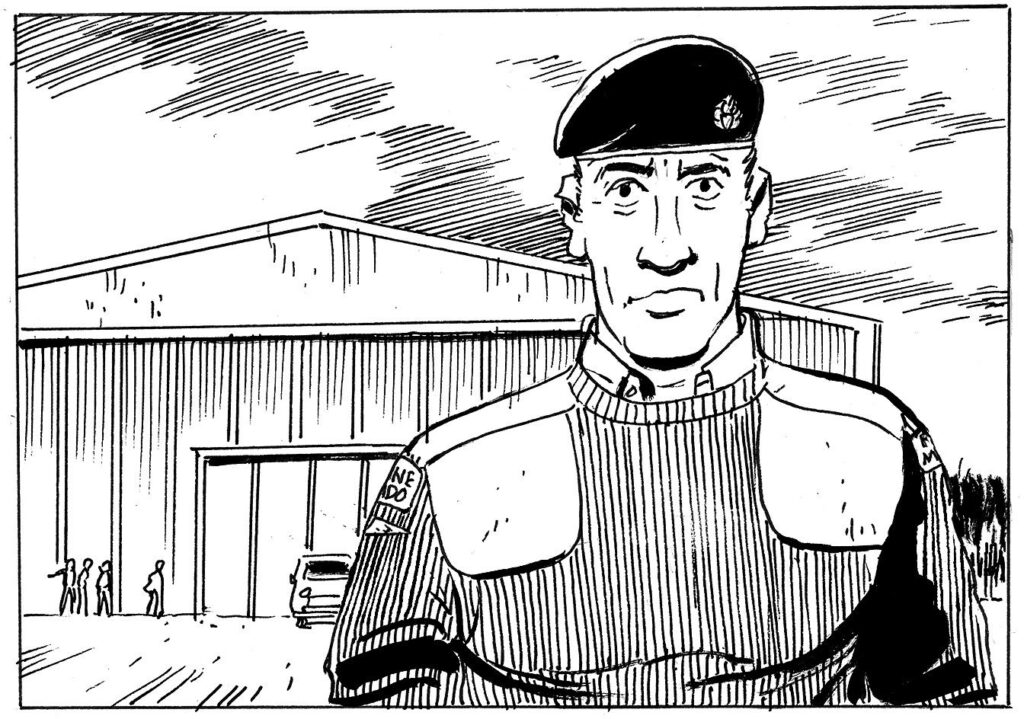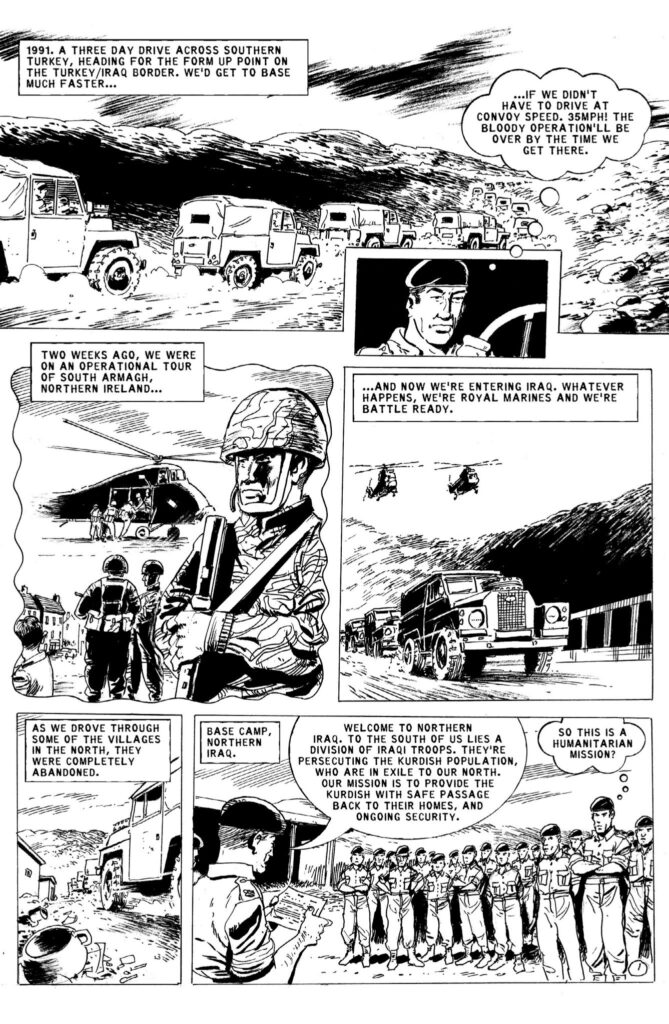Coming Home Issue One, a powerful, thought-provoking blend of military veterans real life stories with art from a range of comic creators, featuring a cover by Ian Kennedy, his last work before his death earlier this year, is on sale today in comic shops across the UK and beyond.
John Freeman caught up with Steve Sullivan at Re-Live, the Arts in Health charity behind the project, to find out more about it…

Can you tell us a bit about Re-Live, and what you do?
Re-Live is an Arts in Health charity, based in Wales. All our work is about working with under represented people and their life stories, supporting them to explore their experiences through the arts. We work with veterans living with complex mental health issues, people living with dementia and their families, older people, and people at the end of life.
How did the “Coming Home” project come about? Are the team comic fans?
Most of Re-Live’s creative work over the last couple of decades has been in making Life Story theatre with our groups, which the people themselves perform in front of an audience.
During lockdown, we started a new online group for veterans living with mental health issues, to talk about their experiences but also explore their stories in a creative way. When one of the veterans asked what all this was going to become, we talked about devising an online theatre performance but it didn’t excite the group. When we talked about other art forms, the one they all connected with was comics. The veterans all had comics in common from childhood, whether it was Commando, Eagle, 2000AD or The Beano/The Dandy.
Is this the first comic project Re-Live has done?
Yep, it’s our first ever Life Story comic. Personally, I’m a lifelong comic fan and former comic shop employee, so to think about actually making a comic was pretty much a dream come true.
However, even though I’ve always read comics avidly, I’d never have known that the process of making an entire comic is so involved with quite so many decisions, from script to layouts to the nuance of every caption. It’s been a really enjoyable learning curve and a great experience putting a comic together for the first time.
How were the stories created? What was the process?
We worked with each of the veterans on Zoom, talking about the stories they wanted to tell and how it could best be adapted into a comic story. Once we had a good feel for each of the stories, we broke them down into panels and scripted them, and the veterans revised every detail until they felt it was exactly the story they wanted to share.
What prompted the choice of artists? Did you go looking, or put out an appeal?
As it was an anthology we wanted to have a range of artists, from traditional British comic artists to newer artists working digitally. I got to spend a lot of time looking to see who was still working in terms of older and established artists, and which more recent artists were doing stand out work. There are so many amazing creators out there, but each artist was chosen according to the story we were telling.
I think the artists we chose are a great fit for each veteran’s story. The first story in the comic is called ‘Safe Haven’ by Robbie, a Royal Marine who was on a humanitarian mission in Northern Iraq.

Robbie really connected with Commando comic, so it was great to be able to work with Keith Page to give the story that perfect Commando look, and it really adds impact when the story doesn’t end the way a normal war comic story would.

Emma Vieceli worked with one of our veterans, Claire, to tell her powerful story of Military Sexual Trauma, called ‘A Healthy Fighting Force’.

It was amazing to see Emma’s work as it came in because she really got the emotions in the story and found ways to bring that out through her panels and layout that were better than we could have imagined.

Clark Bint brought his great mix of hand-inked work and digital wizardry to ‘Hard Shoulder’, a story by Dave about his difficult transition from the military world back to civilian life after decades in the armed forces.


Clark had all the tools to handle the different time periods and flashbacks in the story, and can also draw all the real world details of the modern world. His splash page is a thing of wonder.

The trickiest artist search was for our story “Stretcher-Bearer Stan”. Our veteran storyteller, Stan, was an 18-year-old trombonist, sent to Northern Ireland in the mid-70s. He identified himself at the time like Plug from the Bash Street Kids. So we decided on a Beano-style main character in a more graphically real looking world of barbed wire, uniforms and military vehicles.
Which is great, but there’s not many artists who could work in two separate styles at once and make the overall effect cohesive. Thankfully, Mike Donaldson of The Broons and The Dandy fame exists, and not only brought amazing technical ability but also a real humanity to the story.



There’s a terrific range of comic styles in the published book, all working so well with the stories. Are the team pleased with the results?
I think its fair to say the veterans were all bowled over by what their artists came up with. It could be quite emotional seeing each page as they came in through their different stages, and also cathartic to see your story being visualised.
As you say, the stories are all so different in terms of the look of their artwork, but what combines them all is their artist’s ability to show real emotion and a desire to get the world of it right by each veteran storyteller.
How did Ian Kennedy come to be involved with the project?
I was talking to 2000AD artist David Roach about artists, and whether he had any suggestions for a possible cover artist. When he asked if I’d thought about approaching Ian, it just seemed a long shot to be honest. I knew Ian was 89, and thought there was no way he’d want to take on a new cover commission. Boy, was I wrong. When I asked him through his assistant, Mark Seddon, they came straight back and Ian couldn’t have been keener to support the project.
He worked really collaboratively on what scenarios the cover should depict in order to make sure it reflected mental health situations our veterans would recognise.
He went through several pencil sketches of the layout, and then set about painting what we’d all agreed on. Nothing could have prepared us for how stunning it would look when he’d finished painting. It was such a wow moment to see it for the first time. And then, sadly, within a few days, Ian passed away.



There’s a certain poignancy to the fact that Ian’s final published work, created in his lifetime, reflects the issues facing veterans he so honoured with his dramatic covers for Commando, in particular. Was Ian conscious of the art’s potential impact?
I’ve spoken to Ian’s family several times, and they’d said how much it meant to him to feel he was giving something back to veterans and how strongly he felt that we should support our veterans, no matter what they’re going through. It was clearly a cause he was very passionate about.
He did get to hear from our group about how much they loved what he’d created. It was great to be able to pass that on to him, so he knew just how deeply his cover had been felt and appreciated.
You’re promoting Coming Home as the first issue in a series. Is work already in progress on a second issue and can you tell us which artists are involved?
We’d love to put out Issue 2 of Coming Home, and 3, 4 and onwards. There are other really important veterans’ mental health stories that have already been shared with us, and we know there’s so many more out there that need to be heard.
Are there other issues Re-Live is considering as the possible focus for other comic projects?
As we already work creatively with older people, and people living with dementia, it might be an interesting journey to create more autobiographical Life Story comics. The comics medium has shown us the limitless possibilities on offer in terms of getting someone’s story across, so we’re very keen to explore the idea of making comics with our other groups in the future.
Utilising comics to tell real world stories isn’t new, but using them to highlight social issues has become very popular in recent years. What do you hope Coming Home will achieve in terms of highlighting issues veterans face as they face the move back to a civilian life?
The aim of the comic is to raise awareness about veterans’ mental health and provide new insight into the hidden stories of our ex-service men and women. But also we wanted to make a really great comic, and from the reactions we’ve been getting from all over I’d say we’ve certainly made something that surprises people and really connects with them.
Most importantly for us though, our veterans comic group have found the process of sharing their mental health stories through a comic to have been a really therapeutic process. Telling their stories, seeing them drawn and then sharing them with other people has been the most positive thing for some of them in a long time.
Steve, thank you for your time, and the very best of luck to the are-Live team with your launch – and, hopefully continuing comic creation!
• Coming Home Issue One is released in comic shops in UK, Ireland, USA and Australia on Wednesday 16th November 2022. For a list of stockists visit: www.re-live.org.uk/cominghomecomic
• To celebrate the release, there will be an exhibition of original artwork from Coming Home at The Panel Gallery in Northampton, the UK’s first comic art gallery, from Saturday 19th November-Wednesday 7th December (opening hours Tuesday to Saturday 11.00am – 4.00pm) | Web: thepanelgallery.com
If you don’t have a comic shop near you, you can order the comic directly from Re-Live’s shop
• With the kind permission of Ian Kennedy’s family, Re-Live are offering a limited edition archival print of Ian’s final cover. All proceeds from the sale go directly towards supporting their veterans comics making work
• You can also donate a copy of Coming Home comic to a veteran, supporting Re-Live to send hundreds of copies of the comic to veterans charities and organisations
• Coming Home Issue One is also available to read digitally via Comixology
The founder of downthetubes, which he established in 1998. John works as a comics and magazine editor, writer, and on promotional work for the Lakes International Comic Art Festival. He is currently editor of Star Trek Explorer, published by Titan – his third tour of duty on the title originally titled Star Trek Magazine.
Working in British comics publishing since the 1980s, his credits include editor of titles such as Doctor Who Magazine, Babylon 5 Magazine, and more. He also edited the comics anthology STRIP Magazine and edited several audio comics for ROK Comics. He has also edited several comic collections, including volumes of “Charley’s War” and “Dan Dare”.
He’s the writer of “Pilgrim: Secrets and Lies” for B7 Comics; “Crucible”, a creator-owned project with 2000AD artist Smuzz; and “Death Duty” and “Skow Dogs” with Dave Hailwood.
Categories: British Comics, Comics, Creating Comics, downthetubes Comics News, downthetubes News, Features
 The SEQUENT’ULL Interviews: Dan White
The SEQUENT’ULL Interviews: Dan White  The SEQUENT’ULL Interviews: Michelle Freeman
The SEQUENT’ULL Interviews: Michelle Freeman  The SEQUENT’ULL Interviews: Colossive Press
The SEQUENT’ULL Interviews: Colossive Press  The SEQUENT’ULL Interviews: Comic Creator Mark Stafford
The SEQUENT’ULL Interviews: Comic Creator Mark Stafford